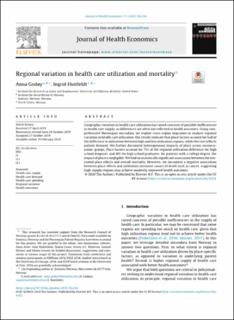Regional variation in health care utilization and mortality
Peer reviewed, Journal article
Published version
Permanent lenke
https://hdl.handle.net/11250/2656087Utgivelsesdato
2020Metadata
Vis full innførselSamlinger
- Publikasjoner fra CRIStin [716]
- Tidsskriftpublikasjon [389]
Originalversjon
10.1016/j.jhealeco.2019.102254Sammendrag
Geographic variation in health care utilization has raised concerns of possible inefficiencies in health care supply, as differences are often not reflected in health outcomes. Using comprehensive Norwegian microdata, we exploit cross-region migration to analyze regional variation in health care utilization. Our results indicate that place factors account for half of the difference in utilization between high and low utilization regions, while the rest reflects patient demand. We further document heterogeneous impacts of place across socioeconomic groups. Place factors account for 75% of the regional utilization difference for high school dropouts, and 40% for high school graduates; for patients with a college degree, the impact of place is negligible. We find no statistically significant association between the estimated place effects and overall mortality. However, we document a negative association between place effects and utilization-intensive causes of death such as cancer, suggesting high-supply regions may achieve modestly improved health outcomes.
